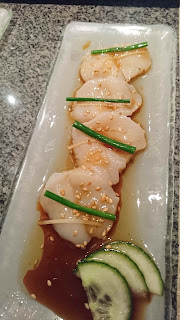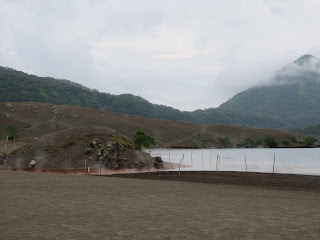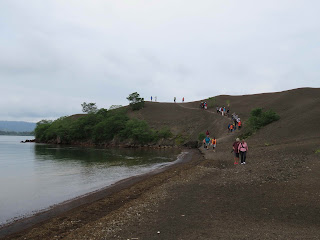Our next island stop after Guadalcanal was Gizo, also in the
Solomon Islands. This island has very little, if any, military history
significance, and it was really being used as another beach day. Unfortunately,
again, our tour - a day at a local resort, with lunch and swimming - was
cancelled due to low numbers, and the descriptions of the other tours really
didn't attract us much.
Gizo was a tender port, and once we found out that the
tender ride was 30 minutes each way, we thought we'd investigate a little
before deciding if we wanted to go ashore. So Larry 'googled' Gizo and
discovered how small the town was and that there was very little to even look
at. That was why all the other tours involved a boat ride to another island!
So Gizo was again turned into an 'in-port sea day' where we
got in some more laps and that sort of thing. The people we talked to later in
the day told us that the islands where the tours went were nice, but there
wasn't much to see, even underwater; but a few who had bargained locally were
taken to some really nice spots and saw quite a bit of fish life while
snorkeling. We did, however, get some beautiful photos of Gizo and the
surrounding islands.
 |
| Gizo Island. The tenders had to go around that huge coral shoal, making for a long ride |
 |
| Nearby islands. Some of the excursions went to the more distant of these. |
 |
| As the day progressed, the sea green of the shallows seemed to get brighter. |
 |
| And for those of you looking, it seems the end of the rainbow is at Gizo. It didn't last more than 5 minutes; we were lucky to get this picture. |
After leaving Gizo, we decided to have dinner at the Sushi
Bar in Silk Road. With only 540 passengers on board for this segment of the
world cruise, the specialty restaurants are not that busy, and it is usually
quite easy to get a last-minute reservation. We had a great time there, and our
chef introduced us to a few menu items that we hadn't tried before.
 |
| The Sushi Bar. It's fun to watch the chefs create the various kinds of sushi for people at the bar and in the rest of Silk Road |
 |
| Scallop sashimi |
 |
| The House Special roll |
 |
| Salmon and tuna tartares |
We'll have to get there one more time before the additional 200
people board the ship in Manila.
On Saturday afternoon we arrived at our next port, Rabaul, Papua
New Guinea, which was a major Japanese harbour during the WW II Pacific
Campaign. Since Guadalcanal was a washout, Larry was hoping for a good military
tour here. Monica was visiting the local volcano, Tavurvur, which is still
quite active, having had its last major eruption in 1994.
The port is a very run-down little town, but that's mainly
because of the 1994 Tavurvur eruption that practically destroyed the place.
After that, the capital of the island of New Britain was moved to the other
side, far enough away, and there's been very little done to improve the
infrastructure since. There are still a couple of industries in Rabaul - the
gas distribution centre, and the Go-Go Cola plant (tastes like Coke),
fortunately not too close to each other - and for the 7 ships that visit every
year, tourism associated with Tavurvur.
 |
| Views over the town of Rabaul from our verandah. There's not much more than this to it. |
 |
| As Larry learned, much of the island of New Britain is covered with coconut palms, so coconut is a main export, as is the coconut husk, which is ground down to make fuel. |
Those of us who remained on board had a treat of our own - a
local traditional dancing presentation that took place in the Galaxy Lounge. We
had been talking to Maria, the Bar Manager, earlier in the day and she
mentioned that Crystal likes to provide refreshments for local groups coming on
board to perform. They usually take the amount of sandwiches that they would
make for the same number of guests and double it...this time they were
expecting to triple the amount they made. Good thing, because over the course
of the day the number of performers kept going up - first it was 26, then it
was 34, and just before dinner it was upgraded to 53!!! And it sure looked like
all 53 were on stage at the end.
 |
| Tribal dance and song. There are over 400 different tribes in Papua New Guinea, and at least 50 just on New Britain. |
 |
| The Mask Dance. |
 |
| The entire cast taking a bow at the end of the performance. |
Make sure you watch this video - we won't tell you what it
is, but know that you may never listen to this song the same way again:
Sunday morning actually dawned nice enough to go on tour,
unlike some of our previous ports. Monica headed off to the volcano and Larry's
tour visited the military sites - and the hot springs near the volcano.
Just riding around town was an adventure, as the paved roads
were full of potholes and the small buses spent much of their time weaving
around them. In fact, it was so bad that in one spot one of the other buses on
Monica's tour actually lost an entire wheel, not just a tire, and had to be
replaced. Fortunately the new bus arrived in about 2 minutes and everyone
carried on.
The first stop on the tour was to see the hot springs
flowing out into the bay. The water is heated to boiling underground by the
volcano, and escapes through a couple of large vents. The steam from this
spring is visible from town, a good 15 minute bus ride away beyond the local
lagoon.
 |
| Another view across the bay to Tavurvur |
 |
| The hot spring. The water is about 100 degrees C when it spills out from underground |
After that, a hike up and down some dunes of volcanic matter
went closer to the base of the volcano, and there was an option to trek all the
way to the top to see the crater. After watching some other hikers making their
way up the narrow and steep passage, and seeing storm clouds brewing over the
island, Monica decided to give that a pass. Vertigo, narrow loose stone
pathways and rain are not the greatest combination.
 |
| Walking toward the volcano. This is all volcanic material, crunchy and quite loose. It was a real challenge to get over some of these dunes. |
 |
| Passing a pond on the way |
 |
| A view of the climbers from our tour making their way up the volcano. At times they had to climb in a human chain, holding hands, because it was so steep. |
 |
| Going back toward the meeting point and parking lot. |
It did in fact rain quite heavily in a brief thunderstorm
before the group of climbers got back down to flat-ish ground, and they were
all soaked by the time they returned to the meeting spot.
Just before the rain hit, Larry's tour also stopped at the
hot spring, and one of our fellow guests, Tom, offered to take a photo for us:
Monica's tour was over at that point, and headed back to the
ship, where the climbers were ready to get out of their wet clothes, put on
bathing suits, and sink into the Jacuzzi hot tubs by the pool to ease their
tired muscles.
Larry's tour turned out to be something of a disappointment.
Leaving the hot springs just as the rain hit, the roads went from being barely
driveable to mostly flooded, which made avoiding the massive potholes even more
fun! The tour continued to see "aircraft wrecks" from the war that
were a mass of metal that could have been anything, and probably were. Then on
to Admiral Yamamoto's Bunker which is located at what is currently the New
Guinea Club, but had been the site of Japanese headquarters. Rabaul had been a
major air/sea base until 1944 and Yamamoto used it as his forward headquarters.
It was from the nearby airfield his flight took off when he was shot down and
killed in 1943. At one time the Club had large collection of war artifacts, but
they were destroyed in the 1994 eruption, leaving just a few pieces.
 |
| Overlooking Rabaul from the volcano monitoring station above town. |
 |
| Seismographs at the monitoring station |
 |
| Crystal Serenity in port |
 |
| A piece of a Japanese Oscar fighter plane |
 |
| Inside 'Yamamoto's Bunker'. Not much there but some Japanese characters uncovered on a wall. |
Monica has been continuing to go to the Knitting group and
the Watercolour Art classes. Here are a couple of pictures of projects she's
done so far. That's not everything - there will be a show on our last sea day
of work from both the knitting and art classes, and we'll post more then.
 |
| 'Early work' - the Whitsunday Islands |
 |
| A flower garden that incorporates some Australian Aboriginal motifs |
 |
| One of Monica's favourites so far. |
We're now heading into a stretch of 5 sea days before our
next port of Boracay, Philippines. Many people have been looking forward to
this, although there are always some who dread being away from land for that
long. We are in the former category - there are lots of lectures and activities
planned; we'll try to give you a sense of them in our next post.







No comments:
Post a Comment